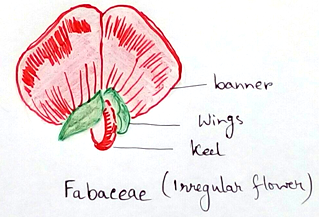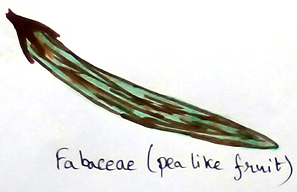Fabaceae Family
Characteristics features of fabaceae:
1. Plants of this family are herbs, shrubs, vines or climbing by twining or tendrils .
2. Root contains root nodules that have nitrogen fixing bacteria (rhizobium) and frequently non protein amino acids are found.
3. Leaves are mostly pinnatus and are spirally arranged, pulvinas of leaf and individual leafletsare well developed.
4. Leaf axis and leaflets usually showing sleep movements.
5. Stipules which are present are sometimes large or are represented by spines.
6. Flowers are usually bisexual, petals are regular or irregular cup shaped hypanthium. Petals are generally five in number.
7. Sepals are usually five in number, free or more commonly connate when a tube with usually valvate lobes or often bilabiate.
8. Irregular petals are – Adaxial small and lying within its laterals in I or large (standard) and outside them (resupinate occasionally) in III.
9. This is imbricate or basally connate, regular and usually valvate.
10. Androecium is with one to numerous stamens but usually ten, hidden by perianth to long- exerted and sometimes showy filaments distinct or connate.
11. If connate is monodelphous or diadelphous , pollen grains are tricolporate, tricolpate or triporate.
12. Gynoecium of one carpel, distinct, usually elongate and with a short gynophore.
13. Ovary is superior with parietal (marginal) placentation.
14. Ovules are anatropous to campylotropous.
15. Fruits are usually legumes.
16. Seeds are hard exotextal, embryo straight to curved with no or less endosperm.
Diagnostic features of the subfamilies of Fabaceae:
They can be divided into three subfamilies –
Mimosoideae – They are shrubs to trees and sometimes occasionally herbs. Leaves are bipinnately compound and the flowers are actinomorphic. Corolla is not radially valvate. Stamens can be minimum ten and maximum upto infinity. Pollen are monads, tetrads or polyads. Seeds are with U- shaped line.
Caesalpinioideae – Plants of this subfamily is trees to shrubs. Occasionally herbs. Leaves are usually pinnately or bipinnately compound. Flowers are more or less distinctly zygomorphic. The upper petals (standard), positioned within the adjacent lateral (wing) petals. Corolla is usually bilateral imbricate and usually showy. Pollen grains are monads stamen are ten in number. Seeds are without Using shaped line.
Papilionoideae – They are herbs, shrubs and. Leaves are pinnately compound to trifoliate occasionally unifoliate. Flowers are more or less zygomorphic – the upper petal (standard) positioned outside the lateral (wing ) petals. Corolla is bilateral vexillary and is showy. Stamens are ten or 9+1. Pollen is monads. Seeds are without U-shaped line.
Economic importance of fabaceae family:
Timber yielding plant – Indian blackwood, Sheesham, Iron wood, Siris, Australian blackwood.
Oil yielding plant - Soybean oil, ground but oil is extracted from some plants of the family.
Dye yielding plant - Dyes like indigo and haematoxylin is also derived from the plants.
Pulses yielding: Lentil, Masur, green gram, pea, chick pea, black gram, urd, mung, pigeon pea, arhar etc. are derived from the plants which are belong to this family.
Medicinal importance - Senna alata uses for skin diseases and vermifuge. Castamospermum australeis monitoring as the probable vaccine for AIDS. Glycyrrhiza glabra used as cough mixture.
From Fabaceae Family to HOME PAGE
Recent Articles
-
Explain about Growth in Plants |Definition of Growth & Differentiation
Feb 27, 25 02:07 PM
Growth is a permanent increase in length or volume of an organism that brought upon by an increase in its dimensions due to synthesis of new protoplasmic material. -
Definition of Respiratory Quotient | calculation | Application | Plant
Dec 02, 24 12:09 AM
Definition of respiration quotient- the ratio of the carbon-dioxide evolved to that of the oxygen consumed by a cell, tissue, plants or animals in a given time is called respiratory quotient. It is us… -
Amphibolic Pathway | Definition | Examples | Pentose Phosphate Pathway
Jun 06, 24 10:40 AM
Definition of amphibolic pathway- Amphibolic pathway is a biochemical pathway where anabolism and catabolism are both combined together. Examples of amphibolic pathway- there are different biochemical… -
Respiratory Balance Sheet | TCA Cycle | ATP Consumption Process
Feb 18, 24 01:56 PM
The major component that produced during the photosynthesis is Glucose which is further metabolised by the different metabolic pathways like glycolysis, Krebs cycle, TCA cycle and produces energy whic… -
Electron Transport System and Oxidative Phosphorylation | ETC |Diagram
Feb 04, 24 01:57 PM
It is also called ETC. Electron transfer means the process where one electron relocates from one atom to the other atom. Definition of electron transport chain - The biological process where a chains…






New! Comments
Have your say about what you just read! Leave me a comment in the box below.